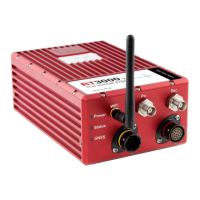Laboratory testing
There are several checks that can be performed in the laboratory to ensure the system is
working correctly. The most fragile items in the system are the accelerometers, the other
items are not subject to shock and do not need to be tested as thoroughly.
Accelerometer test procedure
To check the accelerometers are working correctly, follow this procedure.
1.
Connect power and a laptop to the system.
2.
Commit a default setting to the RT using NAVconfig, then run NAVdisplay.
3.
Click the ‘Calibration’ button, then select the ‘Navigation’ tab and ensure the x, y, and
z accelerations (values 19 to 21) are within specification when the RT is placed on a
level surface in the orientations according to Table 31.
Table 27. Acceleration measurement specifications
This test is sufficient to ensure the accelerometers have not been damaged.
Gyro test procedure
To check that the gyros (angular rate sensors) are working correctly, follow
this procedure:

